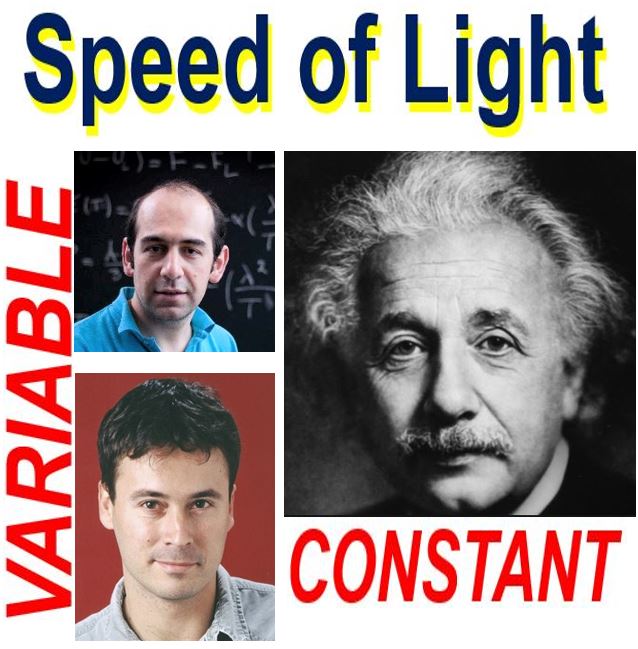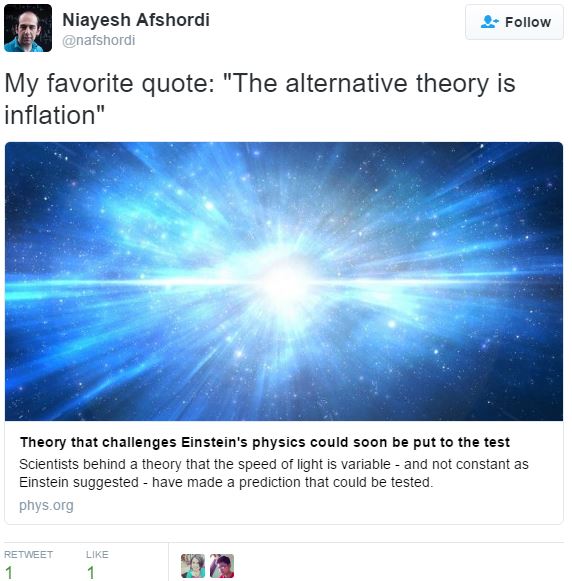The speed of light is variable and we can prove it, say two scientists who are challenging Albert Einstein, who believed that the speed of light is a constant. Einstein said that the speed of light – 186,282 miles per second (299,792 kilometers per second) – stays the same in every situation, and this meant that time and space could be different in different situations.
The assumption of Einstein and scientists after him that the speed of light is, has been and always will be constant, is the basis of many theories in physics, including Einstein’s Theory of General Relativity.
A constant light-speed, in particular, plays a role in models of what occurred in the very early universe, within seconds of the Big Bang.
 Albert Einstein believed that the speed of light cannot change – it is constant. Prof. João Magueijo (bottom left)and Dr. Niayesh Afshordi (top left) suggest that it is variable, and say their theory, unlike others, can be tested. (Images: 1. Prof. Magueijo, imperial.ac.uk. 2. Dr. Niayesh, twitter.com/nafshordi. 3. Albert Einstein, biography.com)
Albert Einstein believed that the speed of light cannot change – it is constant. Prof. João Magueijo (bottom left)and Dr. Niayesh Afshordi (top left) suggest that it is variable, and say their theory, unlike others, can be tested. (Images: 1. Prof. Magueijo, imperial.ac.uk. 2. Dr. Niayesh, twitter.com/nafshordi. 3. Albert Einstein, biography.com)
Speed of light faster before?
However, a number of scientists have suggest that the speed of light may have been considerably faster in this very early universe.
One of the originators of this theory, Professor João Magueijo, who works at the Faculty of Natural Sciences, Department of Physics, Imperial College, London, UK, working with Dr Niayesh Afshordi, from the Perimeter Institute for Theoretical Physics, Waterloo, Ontario, Canada, has made a prediction which he says could be used to test his theory’s validity.
Structures in our universe such as galaxies were formed from fluctuations in the very early universe – minuscule differences in density from one region to another.
The cosmic microwave background contains an imprint – a record – of these early fluctuations. The cosmic microwave background (CMB) is the thermal radiation left over from the time of recombination in Big Bang cosmology. It is a map of the most ancient light in the universe – in the form of a ‘spectral index’.
A very precise 0.96478
Working with their theory – that fluctuations in the early universe were influenced by different speeds of light – Dr. Afshordi and Prof. Magueijo are now using a model to put a precise figure on the spectral index.
 Dr. Afshordi and Prof. Magueijo could be turning many laws of physics on their heads. (Image: twitter.com/nafshordi)
Dr. Afshordi and Prof. Magueijo could be turning many laws of physics on their heads. (Image: twitter.com/nafshordi)
They have written about their research in the prestigious journal Physical Review D (citation below).
Cosmologists across the world are getting progressively more exact readings of this figure, so that prediction could be tested soon – either by ruling out the team’s model of the early universe or confirming it.
Their ‘exact’ figure is a very precise 0.96478, which is very close to the current estimate of readings of the CMB, which with some margin of error, puts it at approximately 0.968.
Prof. Magueijo said:
“The theory, which we first proposed in the late-1990s, has now reached a maturity point – it has produced a testable prediction. If observations in the near future do find this number to be accurate, it could lead to a modification of Einstein’s theory of gravity.”
“The idea that the speed of light could be variable was radical when first proposed, but with a numerical prediction, it becomes something physicists can actually test. If true, it would mean that the laws of nature were not always the same as they are today.”
Varying speed of light vs. inflation theory
The fact that the varying speed of light theory can be tested sets it apart from the ‘inflation’ theory – the more mainstream one. ‘Inflation’ suggests that the early universe went through a phase of mega-fast expansion, considerably faster than the universe’s rate of expansion today.
These theories are essential to overcome what researchers call the ‘horizon problem’, also known as the ‘homogeneity problem’. The universe as we observe it today appears to be broadly the same everywhere, for example, its density is relatively homogenous.
 If the speed of light had been constant since just after the Big Bang, a large area (black) at the edge of the Universe would have no light today. Only if light had traveled much faster than 186,000 miles per second at some time could the whole universe be covered.
If the speed of light had been constant since just after the Big Bang, a large area (black) at the edge of the Universe would have no light today. Only if light had traveled much faster than 186,000 miles per second at some time could the whole universe be covered.
Not enough time if light speed is constant
This could only be possible if every single region in the universe were able to influence every other region. However, if the speed of light has never changed, then light could not have traveled to the edge of the universe – there has not been enough time.
Imagine you are trying to heat up a room with radiators at either end. The warm air coming from the radiators have to travel across the room and mix fully. The problem with the universe, is that the ‘room’ is far too big for this to have happened since it was formed.
If light-speed was considerably faster in the early universe, which the varying speed of light theory suggests, the distant edges could have been connected as the universe expanded.
Later, light would have lost some of its speed in a predictable way as the universe’s density changed. This variability led Dr. Afshordi and Prof. Magueijo to the prediction published today.
According to the inflation theory, the very early universe evened out while it was super tiny, and then suddenly expanded, with the uniformity already in place. While this means that many laws of physics – including the speed of light – are preserved, it requires the invention of an ‘inflation field’ – a series of conditions that only existed at the time.
In an Abstract preceding their main paper in the journal, the authors wrote:
“The critical model makes an unambiguous, nontuned prediction for the spectral index of the scalar fluctuations: nS=0.96478(64). Considering also that no gravitational waves are produced, we have unveiled the most predictive model on offer.”
“The model has a simple geometrical interpretation as a probe 3-brane embedded in an EAdS2×E3 geometry.”
Citation: “Critical geometry of a thermal big bang,” Niayesh Afshordi and João Magueijo. Phys. Rev. D 94, 101301(R). Published 18 November, 2016. DOI: 10.1103/PhysRevD.94.101301.
Video – What is the speed of light?
This Science & Technology 4U documentary is aimed at lay people. It explains what we know about the speed of light.
